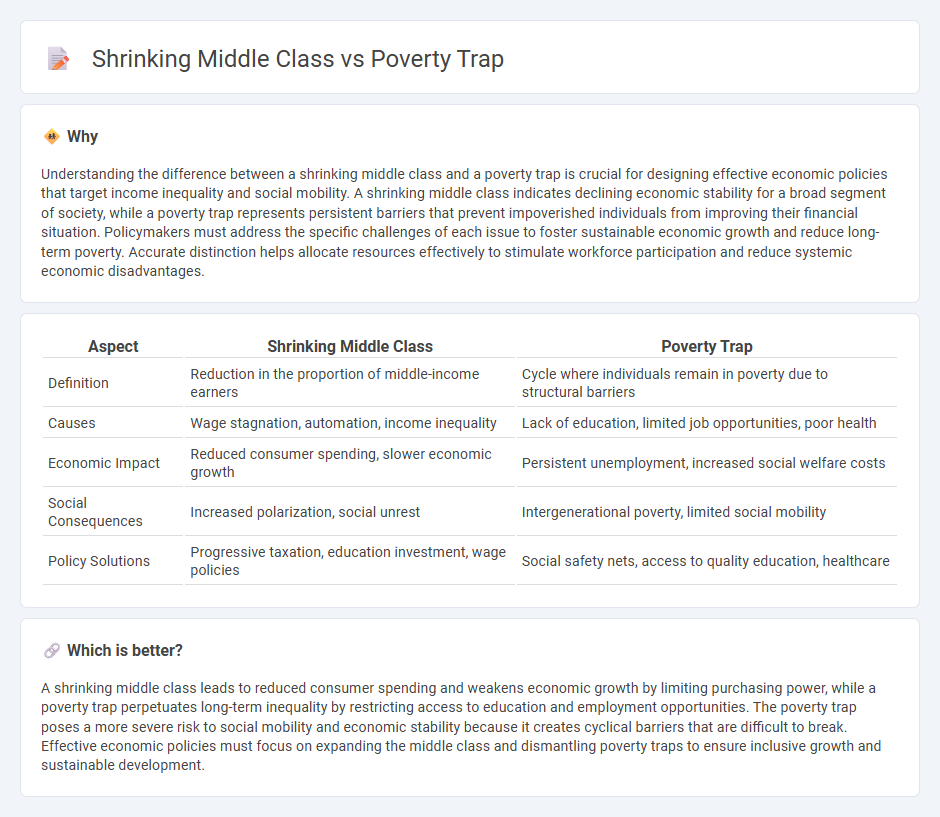
The shrinking middle class signals widening income inequality and reduced economic mobility, with more individuals unable to access opportunities for upward advancement. This contraction often pushes vulnerable populations into the poverty trap, where persistent low income limits education, healthcare, and financial resources necessary for escaping poverty. Explore how these dynamics impact society and what strategies can address economic stagnation and social disparity.
Why it is important
Understanding the difference between a shrinking middle class and a poverty trap is crucial for designing effective economic policies that target income inequality and social mobility. A shrinking middle class indicates declining economic stability for a broad segment of society, while a poverty trap represents persistent barriers that prevent impoverished individuals from improving their financial situation. Policymakers must address the specific challenges of each issue to foster sustainable economic growth and reduce long-term poverty. Accurate distinction helps allocate resources effectively to stimulate workforce participation and reduce systemic economic disadvantages.
Comparison Table
| Aspect | Shrinking Middle Class | Poverty Trap |
|---|---|---|
| Definition | Reduction in the proportion of middle-income earners | Cycle where individuals remain in poverty due to structural barriers |
| Causes | Wage stagnation, automation, income inequality | Lack of education, limited job opportunities, poor health |
| Economic Impact | Reduced consumer spending, slower economic growth | Persistent unemployment, increased social welfare costs |
| Social Consequences | Increased polarization, social unrest | Intergenerational poverty, limited social mobility |
| Policy Solutions | Progressive taxation, education investment, wage policies | Social safety nets, access to quality education, healthcare |
Which is better?
A shrinking middle class leads to reduced consumer spending and weakens economic growth by limiting purchasing power, while a poverty trap perpetuates long-term inequality by restricting access to education and employment opportunities. The poverty trap poses a more severe risk to social mobility and economic stability because it creates cyclical barriers that are difficult to break. Effective economic policies must focus on expanding the middle class and dismantling poverty traps to ensure inclusive growth and sustainable development.
Connection
The shrinking middle class intensifies the poverty trap by reducing economic mobility and access to resources such as education and healthcare, which are crucial for upward movement. Persistent income inequality and stagnant wages limit opportunities for middle-income earners, pushing more individuals into poverty or near-poverty conditions. This cycle perpetuates socioeconomic disparities, making it increasingly difficult for those affected to escape poverty without targeted policy interventions.
Key Terms
**Poverty Trap:**
The poverty trap occurs when individuals or families are unable to escape poverty due to systemic barriers such as limited access to education, healthcare, and capital, creating a self-reinforcing cycle of deprivation. This cycle impedes economic mobility and perpetuates long-term inequality by restricting opportunities for skill development and wealth accumulation. Explore strategies and policies aimed at breaking the poverty trap to foster sustainable financial independence and growth.
Structural Barriers
Structural barriers such as limited access to quality education, inadequate healthcare, and discriminatory labor markets perpetuate the poverty trap by restricting upward mobility and economic opportunity. These same systemic issues contribute to the shrinking middle class, as wage stagnation and job insecurity erode financial stability for many households. Explore how policy reforms targeting these structural obstacles can help break the cycle and revitalize the middle class.
Low Human Capital
Low human capital significantly contributes to the poverty trap by limiting individuals' access to higher-paying jobs and economic mobility, perpetuating cycles of poverty across generations. Similarly, a shrinking middle class reflects inadequate investments in education and skill development, which reduce workforce productivity and economic stability. Explore the implications of low human capital on economic inequality and social advancement to understand potential solutions.
Source and External Links
14.2 The Poverty Trap - Principles of Microeconomics - A poverty trap occurs when government support for the poor declines as their earned income increases, so that working more does not significantly improve their overall income because lost benefits offset earnings.
Cycle of poverty - Wikipedia - A poverty trap, or cycle of poverty, is a self-reinforcing situation where poverty persists across generations due to a lack of resources, education, and social connections, making it very difficult for individuals to escape.
Why do people stay poor? | LSE Research - Empirical evidence suggests that poverty traps involve a critical asset threshold; those who do not receive enough to surpass this threshold remain poor, while those who do can accumulate assets and escape poverty.
 dowidth.com
dowidth.com